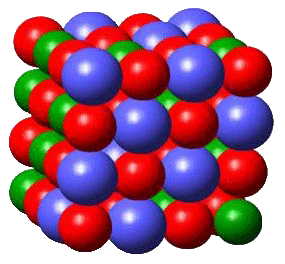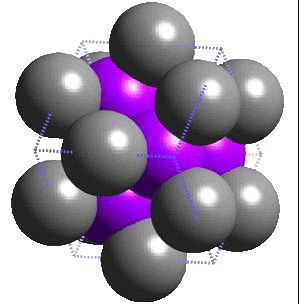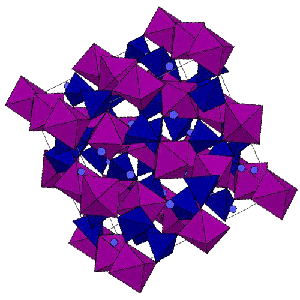 |
 |
 |
 |
 |
 |
 |
 |
We use advanced simulation and modelling techniques to understand the properties of solids and surfaces at the atomic level. Historically most attention in chemistry has been paid to molecules, but it is now clear that ideas from atomistic simulation and ab initio quantum chemistry are capable of providing major insights into materials chemistry. Chemical ideas are proving highly valuable in many areas usually associated solely with condensed matter physics. In addition a wide range of solid-state properties, e.g., behaviour at pressures in excess of millions of atmospheres, are obtainable experimentally only with extreme difficulty, and here simulations are particularly useful; we work a lot with Earth Scientists. We are part of the Centre for Computational Chemistry and are now located in completely refurbished laboratories. We are a small, friendly group - photos here - and collaborate extensively with experimentalists and other theory groups all round the world (from Patagonia to Oslo!). Click on the links at the side to find out more, particularly about our industrial projects.
Recent postgraduate and postdoc members of the Group have gone on to high-profile IT jobs for companies such as LogicaCMG, Orange, molecular modelling jobs in industry or academic positions. More details.
The results of our studies allow us not only to explain and rationalise behaviour but also to make predictions for new systems. The range and type of problems that can be addressed has expanded hughly in recent years due to computational and theoretical advances.
Our primary interest is in inorganic materials and in particular non-metallic solids, e.g. metal oxides, halides, sulphides. We study many aspects of these fascinating systems which are still not understood after at least half a century of hard work. These include the lattice, defect, electronic, magnetic and surface properties. The theoretical methods include lattice statics and dynamics, Monte Carlo and molecular dynamics and ab initio techniques.

Our main efforts have been in the following areas:
Structure and bonding, electronic structure, and defects in oxides, sulphides and phosphides. Our results for the behaviour of the d-electrons, magnetism, and defect states (e.g., Li doped NiO) have challenged much of the conventional wisdom concerning these materials (don't believe all you are taught!), and there is the prospect of further powerful insights. We've also worked a lot on superconducting oxides.
Very recently we have predicted likely structures for phosphorus carbide (in collaboration with the group of Paul May) and predicted the lithium nobiate structure for some as yet unknown ternary ternary fluorides. See some of our work on sulphides.
We're particularly interested in systems of technological importance. We are working on improved understanding of the structure of grossly non-stoichiometric oxides and, for example, the atomistic mechanisms that underlie the behaviour of oxide ion conductors, (with Svein Stølen in Oslo). The local structure, rather than the averaged structure, is absolutely crucial!
Our NEW, GENERAL free energy minimisation program for solids, SHELL, is now available. This program, which uses lattice dynamics, was developed by Drs. Mark Taylor and Gus Barrera, and is the first to perform efficient fully dynamic structure optimisation of unit cells of ionic and polar solids and their surfaces containing hundrds of ions. If you are interested in obtaining a copy of the program email me or Dr. Barrera.
Recent applications are understanding in detail the highly anisotropic (in one direction even negative) expansion of crystalline polyethylene, and the negative expansion of ZrW2O8 over a temperature range of more than 1000 K!.
We also study minerals at the enormous pressures experienced deep in the earth's mantle. We are examining the thermodynamics and mechanisms of relevant phase transitions (click here for an animation).
A range of methods including configurational averaging (via SHELL) and Monte Carlo techniques are also being developed for the study of complex ceramics, minerals and solid solutions at high temperatures. This has enabled the extension of our work to grossly non-stoichiometric systems. This also involves collaboration with Gus Barrera and the group of Svein Stølen in Norway. For the first time we have been able to calculate the entire phase diagram (solid and liquid) of binary oxide systems. These techniques are now being applied to much more complex systems of technological interest, such as oxygen deficient perovskites. Our work is revealing the importance of the local structural environments of individual atoms in determining the properties of highly disordered systems and solid solutions. Mean field theories which average these out usually perform very poorly.
Modelling thin film growth, nanoclusters and interfacial phenomena. Results, for example, for how ions diffuse at oxide surfaces via exchange mechanisms are challenging the conventional wisdom of many decades; these long-time-scale simulations are in collaboration with John Harding (Sheffield). Much of this work is with experimentalists at Bristol, e.g., ongoing projects with the groups of Mike Ashfold (growth of zinc oxide films), Terry Cosgrove (nanowetting) and Paul May (carbon phosphide films). Most recently our predictions that nanofilms of wurtzite materials such as ZnO should adopt graphene layered structures have elegantly been confirmed experimentally.
Understanding incorporation of trace elements into minerals and melts of geological and environmental importance. This is a collaboration with Jon Blundy in the Department of Geology, who runs the related experimental program. We have performed the first direct calculations of trace element partition coefficients. Other geological work involves the simulation of garnets, truly fascinating minerals, with Wim van Westrenen in Amsterdam. Environmental work includes modelling of toxic element incorporation and radiation damage in complex oxides.